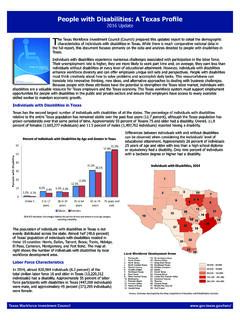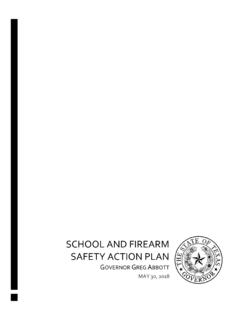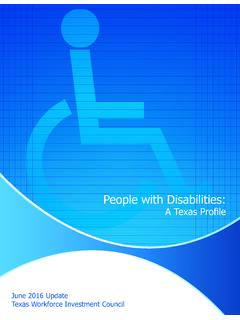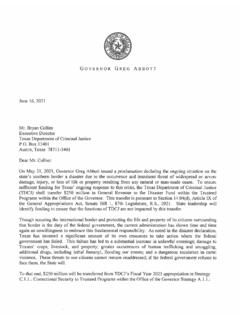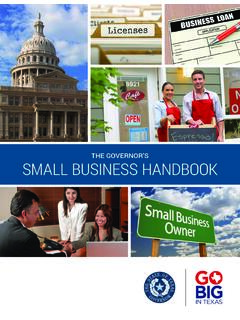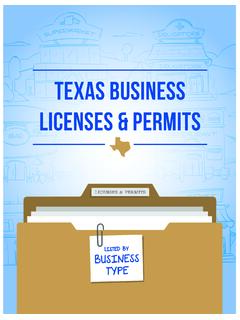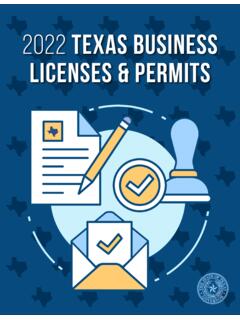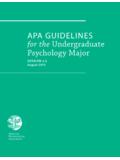Transcription of TEXAS BUSINESS INCENTIVES & PROGRAMS
1 TEXAS BUSINESSINCENTIVES & PROGRAMSOVERVIEWS ummary of State INCENTIVES & ProgramsFINANCINGT exas is committed to providing and facilitating funding for companies and communities with expansion and relocation projects in the state. Asset-based loans for companies, leveraged loans to communities and tax exempt bonds are just a few means of obtaining the capital necessary for a successful project. Capital Access Program Product Development & Small BUSINESS Incubator Fund (PDSBI) The State of TEXAS Industrial Revenue Bond Program (IRB) The TEXAS Military Value Revolving Loan Fund (TMVRLF)GRANTSFrom public infrastructure projects in non-entitlement communities, to cancer research and laboratory facility construction, many types of grants are available to TEXAS communities and businesses. Cancer Prevention & Research General Obligation Bonds Program Defense Economic Readjustment Zone Program (DEAAG) Governor s University Research Initiative (GURI) Skills Development Fund self -Sufficiency Fund TEXAS Enterprise Fund (TEF) TEXAS Moving Image Industry Incentive ProgramTAX INCENTIVEST exas and local communities offer a variety of tax INCENTIVES and innovative solutions for businesses expanding in or relocating to TEXAS .
2 The following INCENTIVES are the most commonly applied offerings. Ad Valorem / Property Tax Exemption Chapter 380 / 381 Economic Development & Diversification In-State Tuition for Employees Franchise Tax Deduction for BUSINESS Relocation Media Production Development Zone Program Renewable Energy INCENTIVES Research & Development Tax Credit Sales Tax Exemptions for Media Productions & Facilities State Sales and Use Tax Exemption TEXAS Economic Development Act / Chapter 313 TEXAS Enterprise Zone ProgramDISCLAIMER: The material contained in this Summary of State INCENTIVES is provided for in-formational purposes only and cannot be construed as a commitment. Assumptions are based on creating jobs and providing a capital investment. Total jobs and capital investment have been included as eligible costs for the various incentive PROGRAMS available. However, actual jobs and capital investment may vary from the assumptions made due to final determination of program eligibility and site : April 2021 FINANCINGCapi tal Access ProgramThe Capital Access Program (CAP) is a partnership between the State of TEXAS and selected non-profit lenders to increase access to financing for small and medium-sized businesses and non-profits which face barriers to accessing capital or fall outside the guidelines of conventional lending.
3 The program facilitates loans which are underwritten by the participating non-profit lenders and supported by the state contributions to a loan loss reserve more information, contact the Economic Development Bank at (512) 936-0100 or visit Development & Small BUSINESS Incubator Fund (PDSBI)Th e TEXAS Product Development and Small BUSINESS Incubator Fund, collectively PDSBI, is a revolving loan program financed through original bond issuances. The Office of the Governor, TEXAS Economic Development Bank administers the funds at the direction of the Governor s appointed nine member board. The primary objective of the program is to aid in the development, production and commercialization of new or improved products and to foster and stimulate small BUSINESS growth in the state. The fund provides asset-based lending with flexible loan terms, competitive Loan-to-Value (LTV) and below-market interest rates. Loan proceeds can be used for a broad range of capital and operating expen-ditures.
4 Your company can secure loans with property, plant or equipment, which can be amortized over the life of the asset. Communities or individual investors can assist as be eligible, applicants must have at least three years of operating history and have unencumbered assets available for collateral. Preference for funding is given to the state s defined industry clusters including, but not limited to: nanotech-nology, biotechnology, biomedicine, renewable energy, agriculture and aerospace. TEXAS is interested in creating and retaining high-quality more information, visit , or contact the TEXAS Economic Development Bank at (512) 936-0100 or The State of TEXAS Industrial Revenue Bond Program (IRB)Industrial Revenue Bonds (IRBs) provide a source of tax-exempt or taxable bond finance for projects involving significant private activity that promote new and existing businesses, encourage employment, and expand the tax base of a com-munity. IRBs are issued by Industrial Development Corporations sponsored by a government unit, but their proceeds are passed on to private businesses, which are generally responsible for debt service payment.
5 Sale s Tax BondsSale s Tax Bonds do not fall under the volume cap and are eligible to communities that have passed the economic de-velopment sales tax (Type A and/or B). Ineligible projects include for-profit hospitals, multi-family projects and municipal BondsBonds can be issued to finance certain facilities such as airports, dock and wharf facilities, governmentally owned solid waste disposal facilities, governmentally owned high-speed inter-city rail facilities, environmental enhancements of hy-dro-electric generating facilities, qualified public education facilities, qualified green building projects, new empowerment zone facilities or government owned solid waste disposal facilities. There is no limit on the amount of the issue and these issues do not require a reservation under the volume cap. Although the facility must be governmentally owned, it may be leased or subject to management contracts with the types of exempt bonds include projects for mass commuting facilities, qualified residential rental projects, qualified enterprise zone facilities, water, sewage and solid waste facilities, facilities for the local furnishing of electricity or gas and local district heating or cooling facilities.
6 These types of exempt-facility issues must reserve a portion of the volume cap. Exempt-facility bonds that are not governmentally owned may reserve up to the greater of $100 million or of the available state ceiling in tax-exempt volume cap allocation each Industrial Revenue BondsTax-Exempt Industrial Revenue Bonds are designed to provide tax-exempt financing to finance land and depreciable property for eligible industrial or manufacturing projects. The maximum bond amount is $10 million, and can include certain capital and administrative January 1, 2007, the maximum capital expenditure amount increased to $20 million. These issues must receive a reservation under the State s volume limitation ( volume cap ) managed by the TEXAS Bond Review Board. Initial reserva-tions of volume cap are allocated by lottery in November prior to the program year; any remaining volume cap is allocated to applicants on a first come, first served basis. For more information, contact the TEXAS Bond Review Board at (512) 463-1741, or visit Military Value Revolving Loan FundCreated by the 78th Legislature, the TEXAS Military Value Revolving Loan Fund, or the Revolving Loan Fund as it has become known, is designed to: Assist defense communities in enhancing the military value of a military facility; Provide financial assistance to defense communities for job creating economic development projects that mini-mize the negative effects of a defense base realignment or closure decision that occurred in 1995 or later; Provide financial assistance to defense communities for an infrastructure project to accommodate new or ex-panded military missions resulting from a base realignment and closure decision that occurred in 1995 or Revolving Loan Fund provides a low cost source of revenue to eligible communities who meet the application cri-teria.
7 The minimum amount of a loan is $1 million, while the maximum amount of a loan is determined by the availability of funds and the creditworthiness of the applicant. State funding will be obtained through the sale of general obligation bonds. The State may provide up to 100% of the cost of the described project, dependent upon the creditworthiness of the applicant. For more information, visit , or contact the TEXAS Military Preparedness Commission at (512) 475-1475. GRANTSC ancer Prevention and Research General Obligation BondsOn November 6, 2007, TEXAS voters approved Proposition 15 - HJR 90, the constitutional amendment which allows the State of TEXAS to establish the Cancer Prevention and Research Institute of TEXAS (the Institute) and allows the Institute to issue $3 billion in general obligation bonds over ten years to fund grants for cancer research and prevention. The Institute may invest the grants strategically in cancer research, clinical trials, and laboratory facility construction in TEXAS .
8 The Institute will continue to implement the TEXAS Cancer Plan. For more information, please visit , or contact the office at (512) Economic Adjustment Assistance Grant The Defense Economic Adjustment Assistance Grant Program (DEAAG), created in 1997, is a job creation grant program designed to assist adversely impacted defense communities that are responding to or recovering from a Depart-ment of Defense Base Realignment and Closure (BRAC) action, or reductions or termination of defense contracts. The program was later expanded to assist defense communities that have been positively affected by BRAC with new or expanded military missions, as well as qualified job funding is available to local municipalities, counties, defense base development authorities, junior college districts, TEXAS State Technical College campuses and regional planning commissions representing these communities. funding is available to meet matching requirements for federal funding or for the purchase of Department of Defense property, new construction, rehabilitation of facilities or infrastructure, or the purchase of capital equipment or insurance.
9 Grants awarded may range from $50,000 to $2 million per more information, please visit , or contact the TEXAS Military Pre-paredness Commission at (512) s University Research Initiative The Governor s University Research Initiative grant program (GURI) was enacted in 2015 by the 84th Legislature with a goal to bring the best and brightest researchers in the world to TEXAS colleges and universities. Through the GURI program, TEXAS welcomes transformative researchers who will in turn serve as economic catalysts to the TEXAS economy for years to come. GURI is a matching grant program to assist eligible TEXAS institutions of higher education in recruiting distinguished researchers, such as Nobel Laureates and members of national honorific societies, from around the world. The program is codified in Chapter 62 of the TEXAS Education Code, Subchapter H and the program s administrative rules may be found in Title 10, Part 5, Chapter 190 of the TEXAS Administrative Code. For more information, visit Development FundThe Skills Development Fund is an innovative program created to assist TEXAS public community and technical colleges finance customized job training for their local businesses.
10 The fund was established by the Legislature in 1995 and is administered by the TEXAS Workforce Commission. Grants are provided to help companies and labor unions form part-nerships with local community colleges and technical schools to provide custom job training. Average training costs is $1,800 per trainee; however, the benefit may vary depending on the proposal. For more information, please contact the TEXAS Workforce Commission at (512) 463-1986, or visit FundThe self -Sufficiency Fund is a job-training program that is specifically designed for individuals that receive Temporary Assistance for Needy Families (TANF). The program links the BUSINESS community with local educational institutions and is administered by the TEXAS Workforce Commission. The goal of the fund is to assist TANF recipients become indepen-dent of government financial assistance. The fund makes grants available to eligible public colleges or to eligible private, nonprofit organizations to provide cus-tomized job training and training support services for specific employers.
